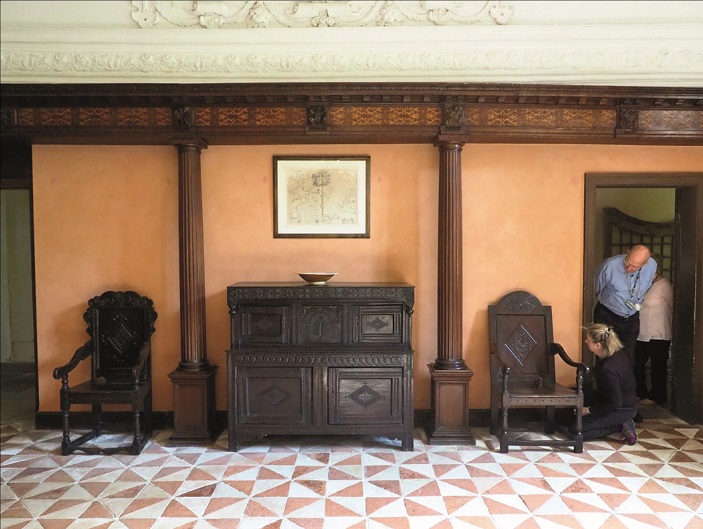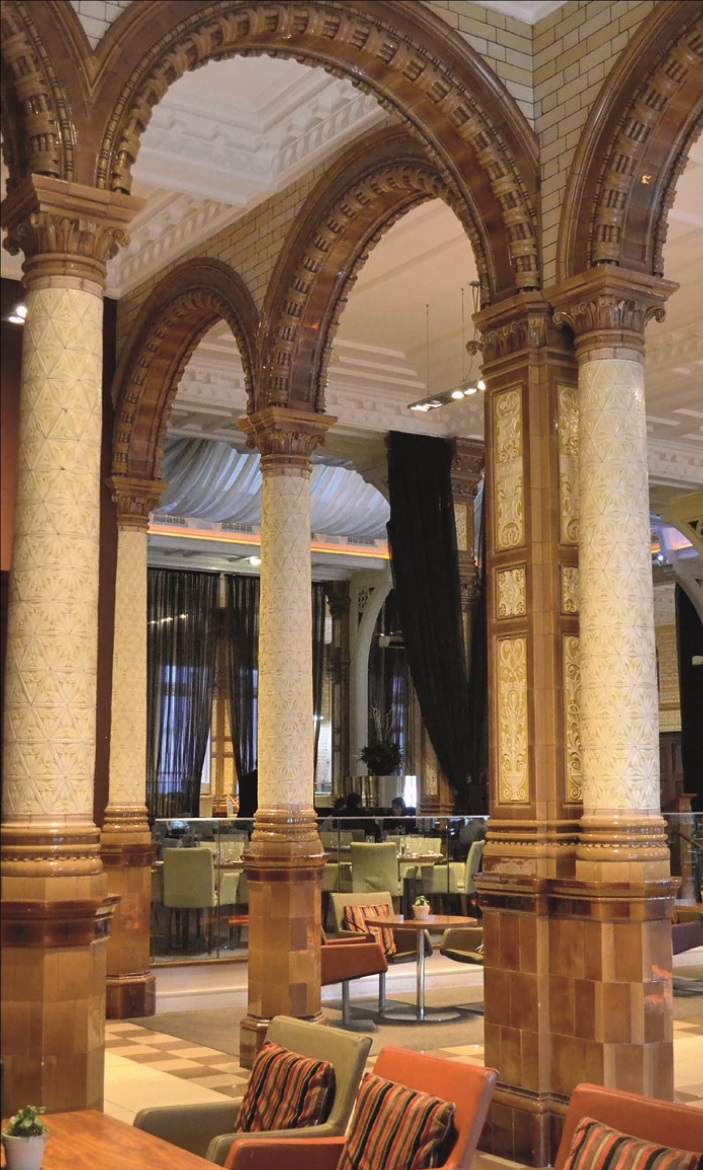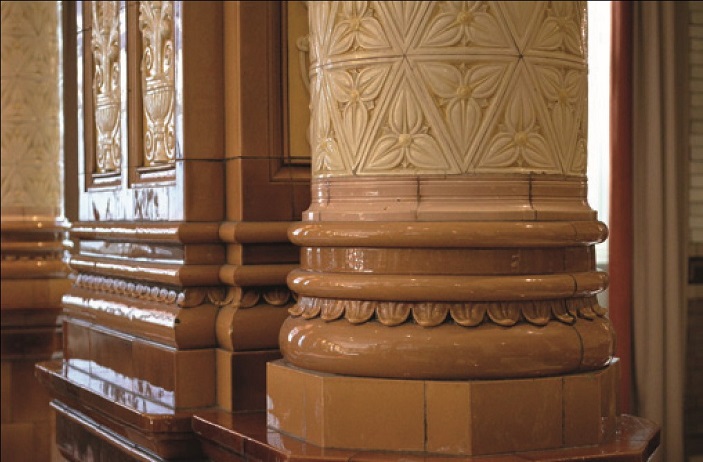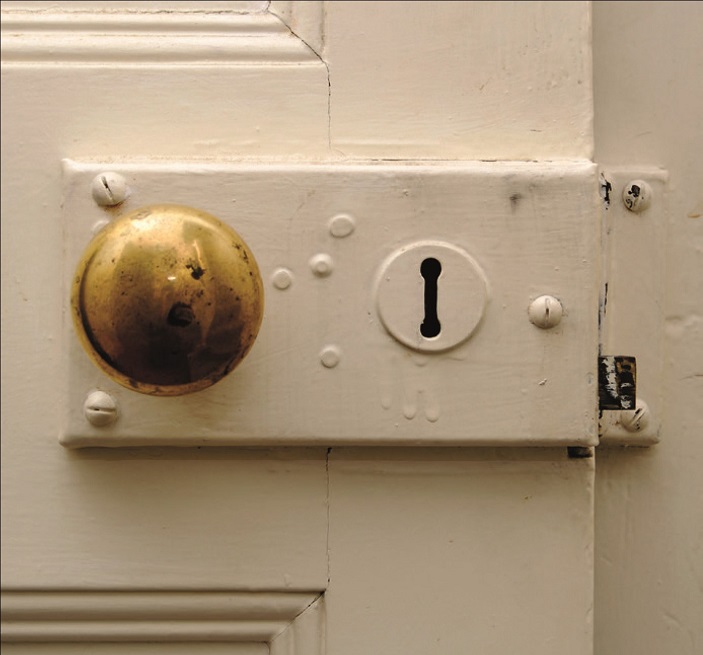Historic Interiors
and Heritage Protection
Jonathan Taylor
 |
| Historic paint investigations being carried out by Lisa Oestreicher at Buckland Abbey, the 17th century home of Sir Francis Drake: paint layers often contain valuable information about the way the interior was decorated in the past. (Photo: Jonathan Taylor, by kind permission of the National Trust) |
In the UK, extensions and alterations to the exterior of buildings usually require consent from the local authority. Alterations to the interior, however, only require consent if the building is listed. In both cases the requirement for consent does not mean that all alterations are prohibited. All buildings need to change over time to satisfy new requirements and to accommodate new technologies, otherwise they would become useless and redundant. The heritage protection system is designed to manage this process, avoiding unnecessary change, and minimising harm to whatever it is that makes the building special.
Each of the UK’s four nations operate slightly different planning and heritage protection systems, but the fundamentals are the same, applying protection for historic buildings through primary legislation supplemented by government policy and guidance, as shown in the table overleaf. These policies and guidance fall into the category of ‘material consideration’ which the planning authority is required to take into account when considering proposals for listed building consent. Local government heritage protection policies which have been through public consultation also fall into this category.
 |
|
 |
The magnificent interior of the former offices of the Refuge Assurance Company in Manchester, designed by Alfred Waterhouse and completed in 1895: the building has been successfully adapted for hotel use and is listed Grade II*. |
The primary legislation enables buildings to be listed, makes it a criminal offence to alter one without listed building consent (LBC), and gives the criterion for granting LBC. Thus, all three acts state that LBC is required for ‘any works for the demolition of a listed building or for its alteration or extension in any manner which would affect its character as a building of special architectural or historic interest’ (1990 Act Section 7, ’97 Act Section 6 respectively, and 2011 Act Article 85 – the wording is identical). The criterion for approval is ‘the desirability of preserving the building or its setting or any features of special architectural or historic interest which it possesses’ (Sections 16 and 14 respectively and Article 85).
Listed buildings are graded according to a variety of factors such as rarity and completeness, with grades I and A being the most important, but all listed buildings are equally protected, whatever the grade, inside and out. The grade or category may have some bearing on ‘the desirability of preserving’ whichever feature or component of the building is to be changed, but interiors are rarely inspected when the building is first listed and an application for LBC may reveal levels of rarity and completeness inside that are not even hinted at externally. Each case is considered on its own merit, irrespective of grade.
The grade or category is, however, used to determine how an application is administered in Britain. Local authorities are required to consult the national statutory body on applications for LBC where a building is to be demolished, but where alterations are proposed, Cadw and Historic England are consulted on proposals to alter Grades I and II* listed buildings only, and Historic Environment Scotland is consulted on categories A and B. In Northern Ireland the Historic Environment Division of the Department for Communities is consulted on all applications for LBC.
Buildings which are of a lower grade or category than those in the table opposite have no statutory protection, although local planning policy may seek to protect them through the control of development. These are called ‘locally listed’ buildings in England and ‘record only’ in Northern Ireland.
|
PRIMARY LEGISLATION |
GOVERNMENT POLICY AND GUIDANCE |
ENGLAND |
Planning (Listed Buildings and Conservation Areas) Act 1990 | The National Planning Policy Framework |
WALES |
Planning Policy Wales, Technical Advice Note 24: The Historic Environment and Managing Change to Listed Buildings in Wales | |
SCOTLAND |
Planning (Listed Buildings and Conservation Areas) (Scotland) Act 1997 | Historic Environment Policy for Scotland and the guidance notes in the Managing Change in the Historic Environment: Use and Adaptation of Listed Buildings |
NORTHERN IRELAND |
The Planning Act (Northern Ireland) 2011 The Planning (General Development Procedure) Order (Northern Ireland) 2015 The Planning (Listed Buildings) Regulations (Northern Ireland) 2015 |
Planning Policy Statement 6 (PPS6): Planning, Archaeology and the Built Heritage Strategic Planning Policy Statement (SPPS) 2015 [PPS6 is being superseded by policies due to be produced by district councils as part of local development plans. These new policies must be in compliance with the SPPS.] |
CONSERVATION AND CHANGE
The core criterion on which all applications for LBC are judged is the ‘desirability of preserving’ the heritage asset affected. In this context the term preserving has been defined through case law as ‘keeping safe from harm’. Since almost any alteration may be considered as harm, including the natural wear and tear that comes through use, it is the desirability of preserving the subject that is held to be the guide to the most appropriate solution. LBC applications are therefore required to show:
• why the building or component affected is significant in heritage terms
• how that significance will be harmed by the proposal, and
• how that harm can be justified.
As Planning Policy Wales (6.1.13) puts it: “Applicants for listed building consent must be able to justify their proposals, show why the alteration or demolition of a listed building is desirable or necessary and consider the impact of any change upon its significance. This must be included in a heritage impact statement, which will be proportionate both to the significance of the building and to the degree of change proposed.” For a minor alteration this can therefore be a relatively simple document.
Larger historic buildings in particular may be expected to have to accommodate significant change many times over the years. Harm can often be mitigated or largely avoided by making the alterations reversible. New components such as partitions must be cut around the existing fabric rather than cutting into the original components, and all interventions must always be kept to the minimum.
LISTED BUILDING GRADES / CATEGORIES (and proportions in each) |
||||
ENGLAND |
Grade I (2.5%) | Grade II* (5.5%) | Grade II (92%) | |
WALES |
Grade I (2%) | Grade II* (6%) | Grade II (92%) | |
SCOTLAND |
Category A (8%) | Category B (50%) | Category C (42%) | |
NORTHERN IRELAND |
Grade A (2.5%) | Grade B+ (6.5%) | Grade B1/B2 (91%) | |
WORKS NOT REQUIRING LISTED BUILDING CONSENT
Like-for-like repairs do not require consent provided they do not involve any alteration or demolition. This means using materials to match the existing (even if the existing materials had been used inappropriately), and the repairs must be limited to the area that needs repairing. All works should be carefully documented with before and after photos and notes detailing what was done. However, most repairs will involve a degree of alteration, so to avoid any misunderstandings the local authority ought to be notified before the work commences.
Likewise, works which would not affect the building’s ‘character as a building of special architectural or historic interest’ may also be carried out without listed building consent. For example, in an old house (say Edwardian or older) this might include replacing modern kitchen or bathroom fittings with more modern ones, on the grounds that the existing fittings are clearly modern interventions which do not contribute to the character or significance of the much earlier building. However, if the new kitchen tops were to rise above the sill of a window, this could affect the character of the building when seen from outside, and would affect the character of the room from the inside, so consent would be required. And there is also the potential for relatively less modern interventions to be considered part of the ‘history’ of the building or part of its significance – for example by association with a famous owner or event.
 |
| Often it is the simple details and the patina of age which give interiors their character and interest, yet these are also the most vulnerable to replacement or over-restoration. |
Works in both the above categories can also inadvertently lead to incidental alterations, particularly where non-specialist craftspeople are unsupervised. For example, it is common to find that contractors have notched the joists to enable heating pipes to run just below the floorboards, weakening the floor structure where it is most vulnerable. Insulation is also often added to meet new EPC targets without realising that it also makes structures beyond the insulation even colder, in some cases causing excessive condensation, mould growth and decay. Furthermore, these problems are not exclusive to contractors alone: often professional consultants too are unfamiliar with traditional building materials and structures, and how incompatible many modern materials and techniques can be.
For all works to historic buildings it is essential to engage the services of professional consultants who specialise in the conservation of historic buildings, both to specify the works and to liaise with the local authority. Where minor works are unlikely to need LBC, they can present a specification that gives the local authority and the owners the confidence they need to proceed without fear of sagging floors, mouldy roof spaces or criminal prosecution.



